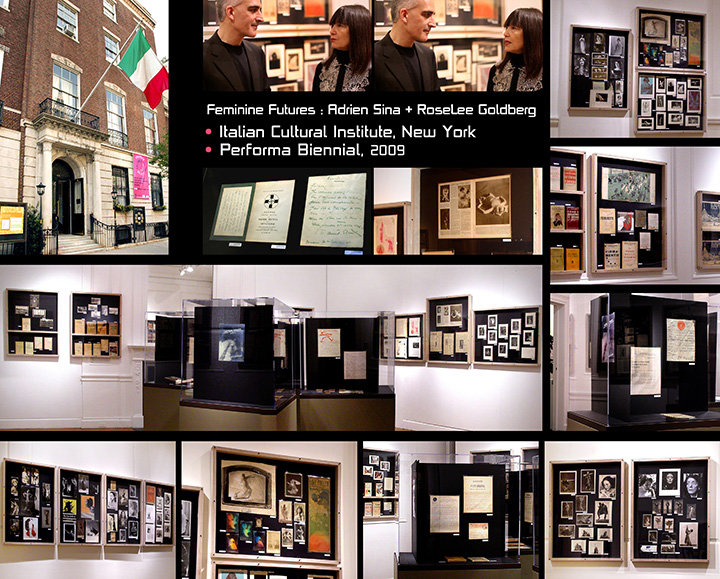

| Feminine Futures Curated by Adrien Sina |

|
Feminine Futures - Valentine de Saint-Point
|

|
A reexamination of the role of female avant-gardes in the fields of performance and dance: a comprehensive publication with over 2500 color illustrations, together with documentary material on Valentine de Saint-Point, Marinetti, Futurism, Canudo, Russian Ballets, Cubism, Abstraction, German and American Expressionism (original photographs, manuscript letters, drawings, woodcuts, manifestos, first editions and ephemera). “Feminine Futures”, an exhibition curated by Adrien Sina, was staged for the Performa Biennial at the Italian Cultural Institute in New York in 2009. It focused on the role of early twentieth-century female avant-gardes in the field of performance and dance. Structured around a unique personal collection, it included a significant number of previously unpublished pieces, some of which subsequently featured in “Danser sa vie” at the Centre Georges Pompidou in 2011-2012.
Texts by Adrien Sina, Giovanni Dotoli, RoseLee Goldberg (Performa), Nancy G. Moore, Philippe de Lustrac, Sander L. Gilman, Frédérique Poissonnier, Maja Durinovic, Sarah Wilson, Patricia Guinard, Eric-Noël Dyvorne, Barbara Ballardin. Feminine Futures. Historical Section, the first half of the twentieth century
The reader confronts the very origins of performance and the
interdisciplinary practices that have inspired generations of artists
through the twentieth century and up to today. A female history of the
avant-garde is pioneered here, freed from the hegemony of the
“isms”, defined by dominant male artists. A new repertoire
of creations and acts of dissidence may be traced through this
magnificent archive and book.
Peaks of plastic and artistic mastery are reached in the collaboration
between photographers and choreographers such as Isaiah West Taber or
Harry C. Ellis with Loïe Fuller, Hixon-Connelly or Herman Mishkin
with Vera Fokina and Anna Pavlova, Lou Goodale Bigelow or Nickolas
Muray with Ruth St. Denis, Isadora Duncan and Arnold Genthe, Charlotte
Rudolph and Hugo Erfurth with Mary Wigman and Gret Palucca, Barbara
Morgan and Chris Alexander or Isamu Noguchi with Martha Graham, Maurice
Seymour and Siegfried Enkelmann with Ruth Page and Harald Kreutzberg... 'La
femme, incitatrice charnelle, immole ou soigne, fait couler le sang ou
l'étanche, est guerrière ou infirmière. Elle est
l'individualité de la foule. Voilà pourquoi aucune
révolution ne doit lui rester étrangère'
Valentine de Saint-Point. Manifeste de la Femme Futuriste, 1912.
The ground level was structured around the French aristocrat Valentine de Saint- Point, the first and only woman artist to be part of the executive board of the Futurist movement, the only futurist who performed in New York (1917). In her ‘Manifesto of the Futurist Woman' (1912) and ‘Futurist Manifesto of Lust' (1913), she theorized broadened territories of artistic activities, linking questions of flesh, desire, gender, war, to political and civilization issues. These ideas were the components of the ‘Feminine Action' that she initiated as a new cross-disciplinary field. Her ‘Art of Flesh' was developed with Ricciotto Canudo, another avant-garde leading challenger for F. T. Marinetti in this stimulating love triangle. The ‘flesh-work' encompasses the history of tragedy, dance and performance, and culminates with her conceptual quest ‘we must make lust into a work of art'. Following her intellectual partnerships, the exhibition dedicated a large section to F. T. Marinetti, then moved to the main figures of Futurism such as Luigi Russolo, Enrico Prampolini, Ardengo Soffici, Anton Giulio Bragaglia, Mario Castagneri, Nelson Morpurgo, Armando Mazza, Enif Angiolini Robert, through issues of theater, performance, war, eroticism and futurist loves. The second floor traced a wider scene of radical experiments, with artists responding to forces rooted in the psychology of desire and in the reconstruction of feminine mythologies and political power which persisted in performance art through the 1960s and beyond. Loïe Fuller, Isadora and Anna Duncan, Ruth St. Denis, Mata Hari, Gertrude Hoffman, Anna Pavlova, Vera Fokina, Ida Rubinstein, Josephine Baker, Giannina Censi, Mary Wigman, Gret Palucca, Hedwig Hagemann, Valeska Gert, Ruth Page, Myra Kinch, Martha Graham... A film program of mostly unseen early performance films completed this section. A history of photography An exceptional convergence filed is opened in the encounter between dance, movement, body language and photography. Genuine artistic strategies remain behind technical processes and their specific pictorial qualities. The photographic pieces of Feminine Futures are also witnesses of the history of photography. Half a century of imaginative mutation between the years 1890' and 1940'... From albumen paper, silver or radium bromides to silver prints, a large chromatic spectrum of chemical experiments are gathered, between stability and selfdestruction of the visible matter. 1 Adrien Sina. « Feminine Futures », pp. 230-235. Catalogue de Performa 09, Back to Futurism. Sous la direction de RoseLee Goldberg. Performa, New York, 2011. 2 Adrien Sina. « Cérémonies Charnelles », pp. 198-201, « Cérémonies Sacrificielles », pp. 382-383. Catalogue de l'exposition Traces du Sacré. Centre Pompidou. Paris, 2008. 3 Adrien Sina. « Avant-gardes féminines du début XXe siècle, dans le champ de la performance et de la danse », pp. 110-117. Catalogue de l'exposition Danser sa vie - Danse et arts visuels aux XXe et XXIe siècles. Centre Pompidou. Paris, 2011. 4 Adrien Sina. « Action Féminine - Valentine de Saint-Point », pp. 44-47. Tate etc., n° 16. Publication associée à l'exposition Futurism, Tate Modern. Londres, 2009. |



| © Adrien Sina |

